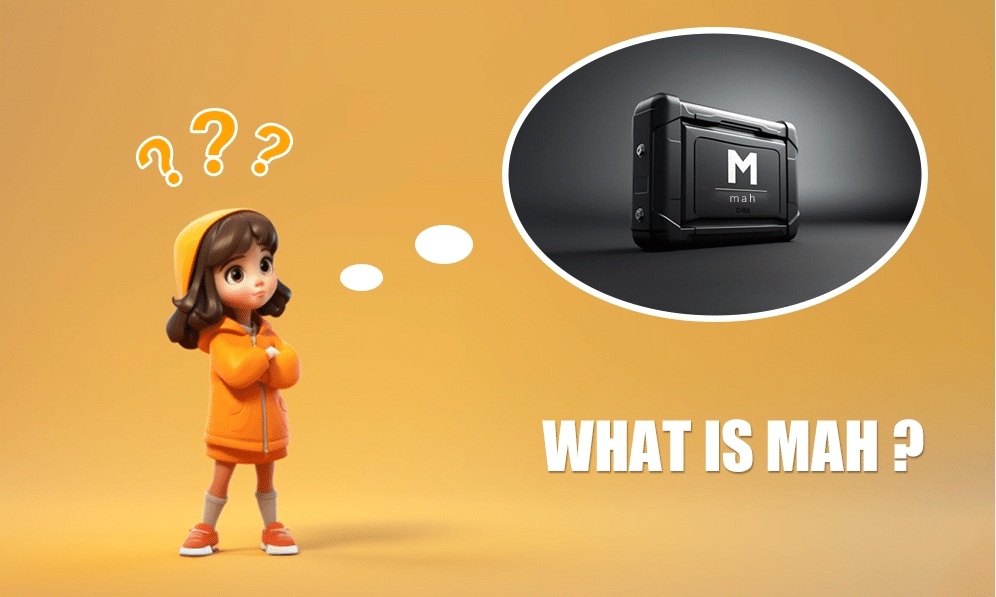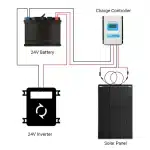
When shopping for devices powered by batteries, you may come across the abbreviations mAh and Ah. The most common question that buyers have when they see this term is, “What is mAh?” mAh, or milliampere-hour, measures the charging capacity of a battery. In technical terms, it defines how much current (in milliamps) can be delivered within one hour.
Batteries with lower mAh ratings can power devices for shorter periods before needing to be recharged. In summary, the lower the mAh, the worse a solar-powered device performs, and the longer the appliances run. Homeowners who want a solar generator as a backup power source should consider mAh (or the exact Ah) before making a purchase. Reliable and efficient power sources are crucial for activities like camping, outdoor adventures, or emergency situations. Additionally, we will be introducing high-power portable solar panels with 2 kilowatt-hours of energy storage to ensure you have the power to meet your needs. Without further ado, let’s get started now.”
What is mAh (Milliampere-Hour)? How Much is mAh?
Now that we have a basic understanding of battery technology, we can delve more into the concept of mAh. In simple terms, mAh is a measure of how much electrical charge a battery can hold. Specifically, it represents the amount of current the battery can deliver within one hour after being fully discharged.
Milliampere-hour (or mAh for short) is a power measurement method that changes over time. In other words, it refers to the amount of charge a battery can hold or the duration it lasts after being charged. Let’s use an intuitive example to better grasp this concept.
Think of mAh like the fuel tank of a car. The amount of gas that can be filled into the tank represents the tank’s capacity. If the tank is smaller, you can only go a shorter distance before needing to refuel. Similarly, if the battery capacity (or mAh) is smaller, the duration between two charges will also be shorter.
Understanding mAh will help you choose the right solar generator for your home or outdoor adventures. The intuitive formula for calculating mAh from watt-hours for solar panels is:
mAh = Wh * 1000 / V
For example, if a battery is 200 watt-hours at 5V, it may have:
200 Wh * 1000 mAh / 5V = 40,000 mAh
This means a battery rated at 40,000 mAh can power a device consuming 400 mAh for 10 hours. Now that you know what mAh is, let’s explore its significance and how it differs from charging capacity.
It’s important to note that mAh is not the sole factor determining battery life. Other factors like device type, screen brightness, and usage patterns also have a significant impact on battery runtime. However, mAh serves as a useful starting point for understanding battery capacity and comparing different devices.”
The Relationship Between mAh and Battery Charging Time
In addition to battery life, the mAh rating also affects charging time. Batteries that can hold more charge typically require more time to charge. Batteries with higher mAh ratings generally take longer to charge compared to those with lower ratings.
The battery’s chemical composition also plays a significant role in charging time. For instance, portable power banks can be charged in as little as 60 minutes or less using household electricity, while charging them with solar panels may take anywhere from 2 to 6 hours.”
mAh (Milliampere-Hour) and Charging Capacity
mAh (Milliampere-Hour) and charging capacity describe the battery’s capacity or how much charge it can hold. While they represent the same concept, they are used in slightly different contexts.
mAh typically describes the battery capacity of portable devices like tablets and laptops. It is a unit that represents the amount of energy any battery can store. On the other hand, charging capacity defines the battery capacity in solar energy storage systems and electric vehicles. It measures the energy the battery can accept during the charging cycle, often measured in kWh or Wh.
In summary, charging capacity quantifies energy, while mAh defines battery capacity.
One thing to remember: capacity and energy are two different concepts. Ampere-hours measure the charge and define battery capacity, while watt-hours estimate energy.
Now, let’s discuss the relationship between mAh and charging capacity.
Watt-hours = Milliampere-Hours * Voltage / 1000
Assuming you have a 10,500mAh battery. This means it can provide a total charge of 10,500mAh at a specific voltage. Let’s assume the voltage at which the charge is flowing is 3.7V. So, in this case, the total energy would be 10,500mAh * 3.7V / 1000 = approximately 38Wh.”
The meaning of mAh rating:
The mAh rating is a unit of measurement for battery capacity, representing the product of the current a battery can output in a discharged state and the time it can do so. Typically, batteries are labeled with their mAh rating, which indicates the amount of time and current intensity the battery can supply to a device.
Formula: mAh rating = milliampere-hours (mA·h)
For example, if a battery has a rated voltage of 6V and a capacity of 1500mAh, it can provide 6 volts for 15 hours at a current of 100mA (100mA × 15h = 1500mAh). In other words, this battery can power a device for 15 hours.
The higher the mAh rating, the larger the battery’s storage capacity, and the longer it can power a device. Therefore, when purchasing batteries or choosing battery-powered devices, the mAh rating is a crucial parameter.
What does mAh on a battery mean?
mAh is commonly used to describe battery capacity and is a unit of electrical charge. Higher mAh batteries are measured in ampere-hours (Ah), where 1 Ah equals 1000 mAh. The larger the milliampere-hour rating of a battery, the more electrical charge it can store. Thus, only higher mAh batteries can provide longer runtimes for your devices.
What does mAh mean for rechargeable batteries?
Unlike disposable batteries that are discarded after use, rechargeable batteries can be recharged after their charge is depleted. They can be charged thousands of times and are suitable for high-power devices. The milliampere-hour rating of rechargeable batteries can be considered similar to that of regular batteries.
What does mAh mean for car batteries?
In general, the milliampere-hour rating for car batteries indicates how long your car can run without needing a recharge. It measures how much electrical charge the car battery can hold.
A higher mAh rating for car batteries means a larger storage capacity and longer runtime. There are various types of car batteries available; however, the most common types are lithium-ion batteries and lead-acid batteries.
Lead-acid batteries typically have a mAh capacity ranging from 135-300 charge cycles. They have a relatively short lifespan and require replacement every 3-5 years.
On the other hand, lithium-ion batteries have higher mAh ratings and longer lifespans. Their mAh charge cycles range between 300-400, and they can last for over 5 years.
Does it matter what mAh battery you use?
the mAh (milliampere-hour) rating of a battery does matter, and it plays a crucial role in determining how long a device can operate between charges. The mAh rating represents the capacity of the battery to store electrical energy. In simple terms, a higher mAh rating means the battery can store more energy and, therefore, potentially power a device for a longer period.
Here’s how it matters:
- **Battery Life:** A battery with a higher mAh rating can provide longer battery life to a device. For example, a smartphone with a 3,000mAh battery is likely to last longer between charges than one with a 2,000mAh battery, assuming all other factors are equal.
- **Device Compatibility:** It’s essential to use a battery with a mAh rating that is compatible with your device. Using a battery with a significantly lower mAh rating than what your device requires may result in shorter usage time and more frequent recharges.
- **Device Size and Weight:** Batteries with higher mAh ratings tend to be physically larger and heavier. Therefore, when choosing a battery for a device, you need to consider whether it fits within the device’s design and if the added weight is acceptable.
- **Charging Time:** Charging a battery with a higher mAh rating may take longer, especially if you’re using a charger with a lower current output. So, there might be a trade-off between battery capacity and charging speed.
- **Cost:** Batteries with higher mAh ratings are often more expensive. You should balance your need for extended battery life with the cost of purchasing a higher-capacity battery.
In summary, the mAh rating matters because it directly affects how long your device can run on a single charge. It’s essential to choose a battery with an appropriate mAh rating that aligns with your device’s power requirements and your usage patterns.
Does higher mAh batteries charge faster?
No, higher mAh (milliampere-hour) batteries do not charge faster inherently. The mAh rating of a battery indicates its capacity to store electrical energy, which determines how long a device can operate on a single charge. It does not affect the speed at which the battery charges.
The charging speed primarily depends on the charger’s current output (measured in amperes or A) and the device’s charging circuitry. A charger with a higher current output can charge a battery more quickly, regardless of its mAh rating.
For example, if you have two batteries with different mAh ratings but use the same charger with the same current output for both, they will charge at the same rate in terms of current. However, the battery with the higher mAh rating will take longer to reach a full charge because it has a larger capacity to fill.
In summary, the charging speed is determined by the charger and its current output, not the mAh rating of the battery. Higher mAh batteries may take longer to charge because they have a larger capacity to replenish, but the charging speed itself is not influenced by the mAh rating.
How to Convert mAh to Ah:
To convert milliampere-hours (mAh) to ampere-hours (Ah), you divide the charge Q in milliampere-hours by 1000:
Q (Ah) = Q (mAh) / 1000
So, ampere-hours are equal to milliampere-hours divided by 1000:
Ah = mAh / 1000
Or, you can express it as:
Ah = mAh / 1000
Example:
How do you convert 300 milliampere-hours to ampere-hours?
The charge Q is equal to 300 mAh divided by 1000:
Q = 300mAh / 1000 = 0.3Ah
Direct Current (DC) Amperes to Kilowatts Calculation Formula:
Power P (kW) is equal to the current I (A) multiplied by the voltage V (V) divided by 1000:
P (kW) = I (A) × V (V) / 1000
So, kilowatts are equal to amperes multiplied by volts divided by 1000:
kW = A × V / 1000
Or, you can express it as:
kW = A × V / 1000
**Example:**
What is the power (kW) when the current is 3A and the power supply voltage is 110V?
Answer: Power P is equal to 3 amperes of current multiplied by 110 volts of voltage, then divided by 1000.
P = 3A × 110V / 1000 = 0.33 kW
Alternating Current (AC) Amperes to Kilowatts Calculation Formula:
Active power P (kW) is equal to the power factor PF multiplied by the phase current I (A), multiplied by the RMS voltage V (V), divided by 1000:
P (kW) = PF × I (A) × V (V) / 1000
So, kilowatts are equal to the power factor multiplied by amperes multiplied by volts divided by 1000:
kW = PF × A × V / 1000
Or, you can express it as:
kW = PF × A × V / 1000
**Example:**
What is the power (kW) when the power factor is 0.8, the phase current is 3A, and the RMS voltage of the power source is 110V?
Answer: Power P is equal to the power factor 0.8 multiplied by 3 amperes of current multiplied by 110 volts of voltage, then divided by 1000.
P = 0.8 × 3A × 110V / 1000 = 0.264 kW
In summary
mAh is a key factor in understanding battery capacity and selecting electronic devices that meet our needs. While it’s not the only factor affecting battery life, it is an important starting point for comparing devices and making informed decisions. By understanding the basics of electricity and battery technology, we can better grasp how mAh works and use this knowledge to make wiser purchasing decisions.
Learn more about it:
What does amp mean: A Beginner’s Guide
What does ‘Ah’ on a battery mean?
Electricity Uncovered: Volts to Watts Conversion
Explanation of Watts vs Watt hours, Amp hours vs Watt hours








